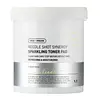What's inside
What's inside
 Key Ingredients
Key Ingredients

 Benefits
Benefits

 Ingredients Side-by-side
Ingredients Side-by-side

Water
Skin ConditioningGluconolactone
Skin ConditioningPentylene Glycol
Skin ConditioningIsopentyldiol
HumectantTranexamic Acid
AstringentBetaine
HumectantPropanediol
SolventAzelaic Acid
BufferingAscorbic Acid
AntioxidantCitrus Aurantium Amara Fruit Extract
Skin ConditioningCitrus Aurantium Sinensis Peel Extract
Skin ConditioningCitrus Reticulata Fruit Extract
Skin ProtectingGlycerin
HumectantAllantoin
Skin ConditioningPolyglycerin-6
HumectantInulin
Skin ConditioningFructose
HumectantGlucose
HumectantXanthan Gum
EmulsifyingCellulose Gum
Emulsion StabilisingLactic Acid
BufferingCitric Acid
BufferingSodium Phytate
Cellulose
AbsorbentWater, Gluconolactone, Pentylene Glycol, Isopentyldiol, Tranexamic Acid, Betaine, Propanediol, Azelaic Acid, Ascorbic Acid, Citrus Aurantium Amara Fruit Extract, Citrus Aurantium Sinensis Peel Extract, Citrus Reticulata Fruit Extract, Glycerin, Allantoin, Polyglycerin-6, Inulin, Fructose, Glucose, Xanthan Gum, Cellulose Gum, Lactic Acid, Citric Acid, Sodium Phytate, Cellulose
Water
Skin ConditioningMethylpropanediol
SolventGlycerin
HumectantDipropylene Glycol
HumectantXylitol
HumectantBetaine
HumectantGlyceryl Glucoside
HumectantCarbomer
Emulsion StabilisingArginine
MaskingDisodium EDTA
Ammonium Acryloyldimethyltaurate/Vp Copolymer
Panthenol
Skin ConditioningButylene Glycol
HumectantMelaleuca Alternifolia Leaf Extract
PerfumingPortulaca Oleracea Extract
Skin ConditioningGlucose
HumectantXylitylglucoside
HumectantAnhydroxylitol
HumectantGlyceryl Acrylate/Acrylic Acid Copolymer
HumectantCentella Asiatica Extract
CleansingChamaecyparis Obtusa Leaf Extract
Skin ConditioningSodium Hyaluronate
HumectantMadecassoside
AntioxidantMadecassic Acid
Skin ConditioningAsiaticoside
AntioxidantAsiatic Acid
Skin ConditioningPropolis Extract
Skin Conditioning1,2-Hexanediol
Skin ConditioningEthylhexylglycerin
Skin ConditioningHydroxyacetophenone
AntioxidantCaprylyl Glycol
EmollientWater, Methylpropanediol, Glycerin, Dipropylene Glycol, Xylitol, Betaine, Glyceryl Glucoside, Carbomer, Arginine, Disodium EDTA, Ammonium Acryloyldimethyltaurate/Vp Copolymer, Panthenol, Butylene Glycol, Melaleuca Alternifolia Leaf Extract, Portulaca Oleracea Extract, Glucose, Xylitylglucoside, Anhydroxylitol, Glyceryl Acrylate/Acrylic Acid Copolymer, Centella Asiatica Extract, Chamaecyparis Obtusa Leaf Extract, Sodium Hyaluronate, Madecassoside, Madecassic Acid, Asiaticoside, Asiatic Acid, Propolis Extract, 1,2-Hexanediol, Ethylhexylglycerin, Hydroxyacetophenone, Caprylyl Glycol
 Reviews
Reviews

Ingredients Explained
These ingredients are found in both products.
Ingredients higher up in an ingredient list are typically present in a larger amount.
Betaine is a common humectant (a substance that promotes retention of moisture). It's known to be gentle on the skin and can help balance hydration.
This ingredient is best for improving hydration and soothing irritated skin. Studies also show it helps even out skin tone.
Fun fact: Betaine is naturally created in the skin and body. The kind found within cosmetic products can be either plant-derived or synthetic.
Another name for betaine is trimethylglycine.
Learn more about BetaineGlucose is a simple sugar and is the most important source of energy in all organisms.
In skincare, glucose is used to hydrate the skin. It also acts as a prebiotic for our natural biome.
Glucose is hydrating due to its humectant property. As a humectant, glucose draws moisture from the air and from deeper levels in the skin.
Our skin contains many sugars that act as prebiotics and help strengthen our natural microbiome. Having a healthy microbiome helps protect our skin from harmful bacteria and other contaminants.
Studies show glucose may help with fading discoloration and pigmentation. This is because our skin metabolizes glucose into lactic acid. Lactic acid is an AHA that helps exfoliate the top layer of skin.
Learn more about GlucoseGlycerin is already naturally found in your skin. It helps moisturize and protect your skin.
A study from 2016 found glycerin to be more effective as a humectant than AHAs and hyaluronic acid.
As a humectant, it helps the skin stay hydrated by pulling moisture to your skin. The low molecular weight of glycerin allows it to pull moisture into the deeper layers of your skin.
Hydrated skin improves your skin barrier; Your skin barrier helps protect against irritants and bacteria.
Glycerin has also been found to have antimicrobial and antiviral properties. Due to these properties, glycerin is often used in wound and burn treatments.
In cosmetics, glycerin is usually derived from plants such as soybean or palm. However, it can also be sourced from animals, such as tallow or animal fat.
This ingredient is organic, colorless, odorless, and non-toxic.
Glycerin is the name for this ingredient in American English. British English uses Glycerol/Glycerine.
Learn more about GlycerinWater. It's the most common cosmetic ingredient of all. You'll usually see it at the top of ingredient lists, meaning that it makes up the largest part of the product.
So why is it so popular? Water most often acts as a solvent - this means that it helps dissolve other ingredients into the formulation.
You'll also recognize water as that liquid we all need to stay alive. If you see this, drink a glass of water. Stay hydrated!
Learn more about Water